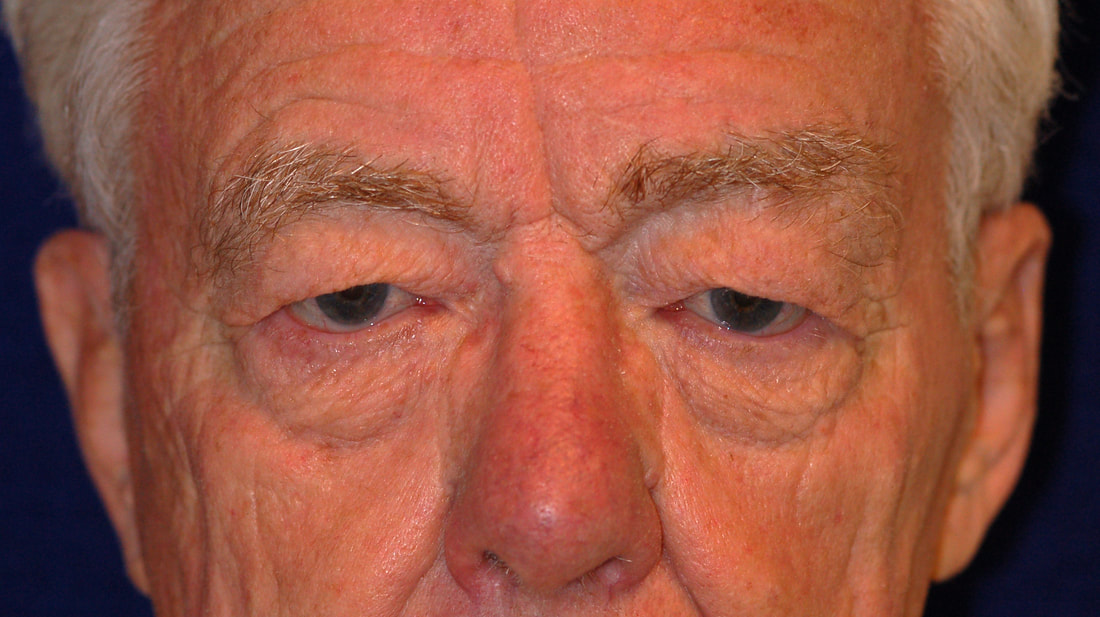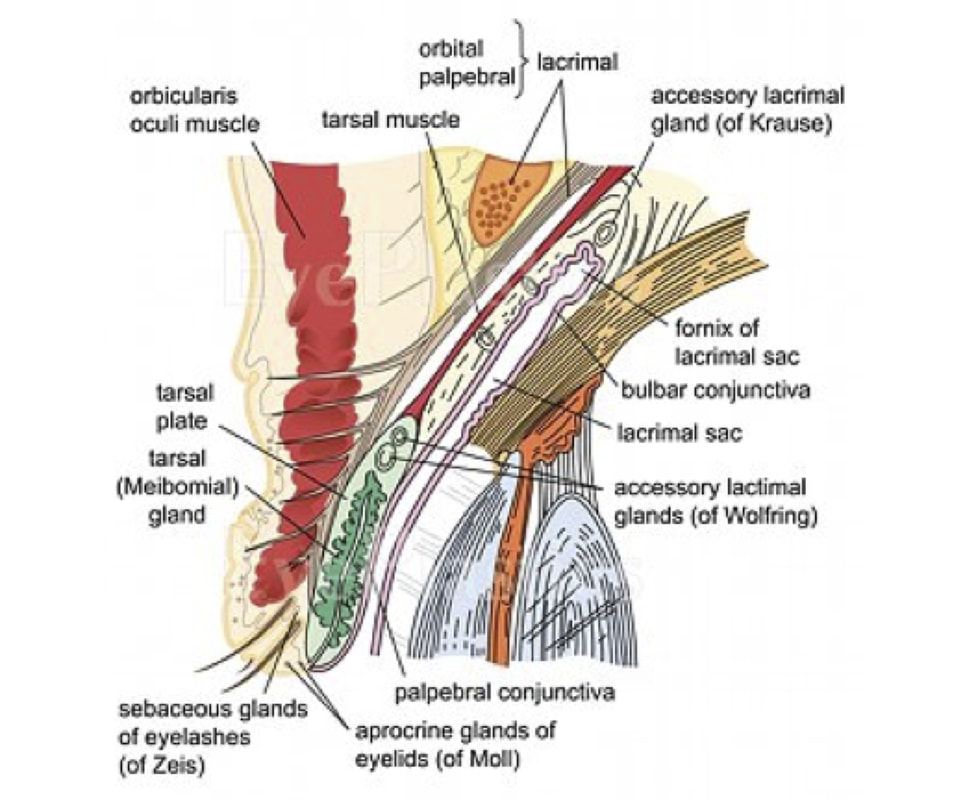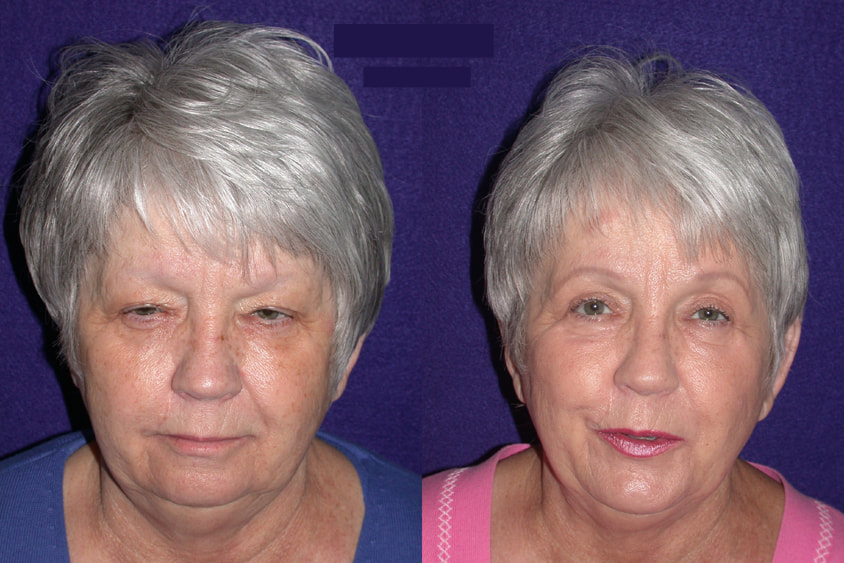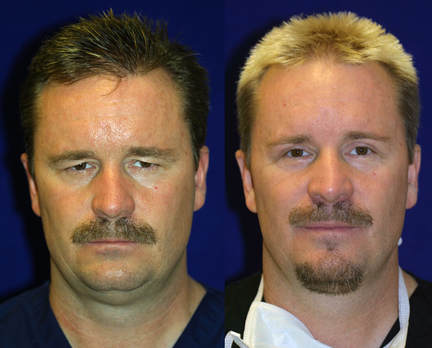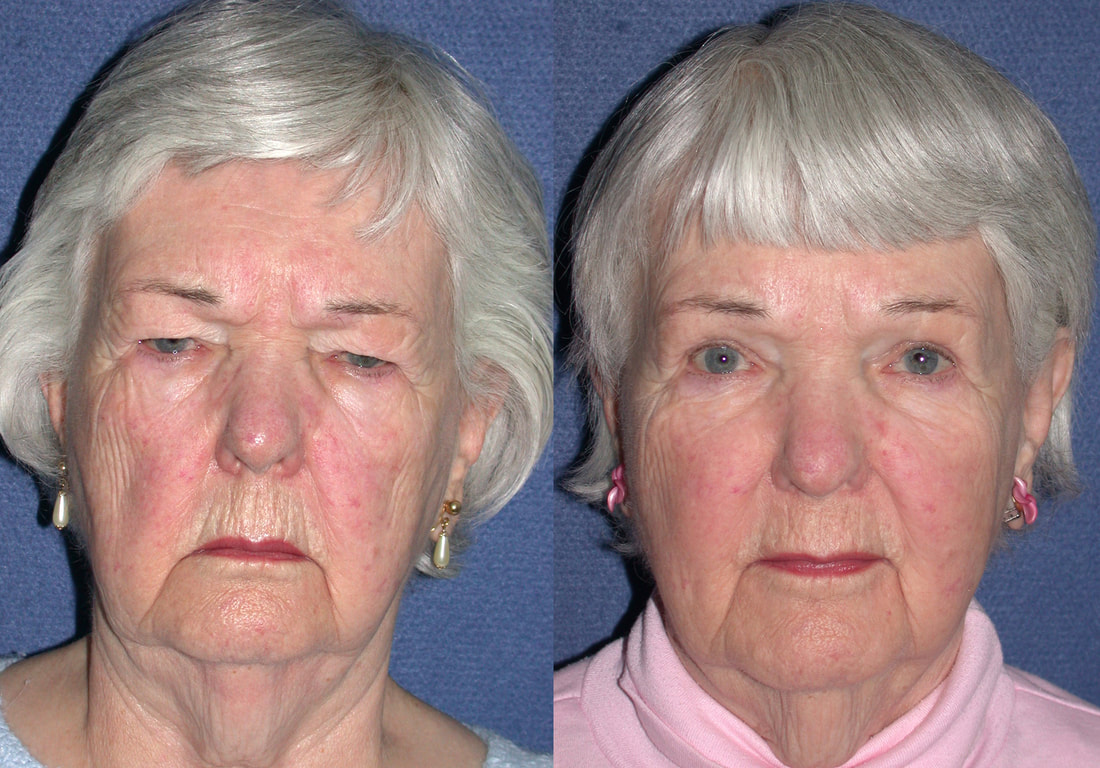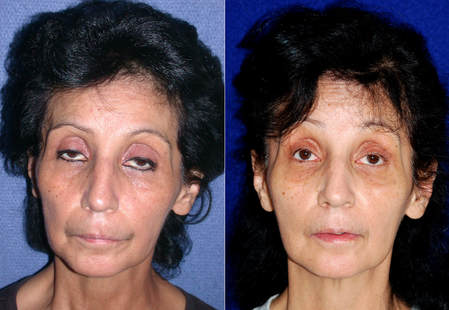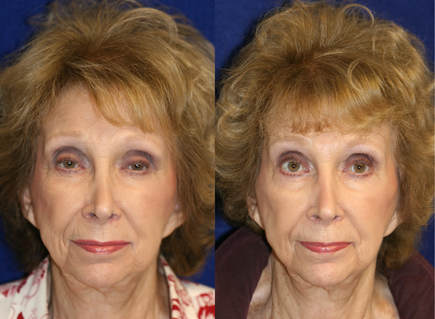What is Acquired Ptosis?
Acquired ptosis: occurs when there is stretching or dis-insertion of your levator aponeurosis. The levator muscle normally sends an aponeurosis (like a tendon of a muscle) to the upper eyelid tarsal plate which allows the lid to be lifted when you try to open your eyelids. Some attachments are also sent to the upper eyelid skin which allows you to have a normal eyelid skin crease and also allows the skin on the upper eyelid tarsal plate to be lifted when you open your eyelids which allows your eyelashes to stand firm and to attention!
Ptosis rarely occurs just by itself: frequently, at least in adults, there may be bilateral ptosis and dermatochalasis (see below) as well as asymmetry of brows and sometimes lower eyelid laxity. This does not mean that everything needs to be addressed: however, one needs to assess these changes to that proper decisions may be made by the patient and by us!
Ptosis rarely occurs just by itself: frequently, at least in adults, there may be bilateral ptosis and dermatochalasis (see below) as well as asymmetry of brows and sometimes lower eyelid laxity. This does not mean that everything needs to be addressed: however, one needs to assess these changes to that proper decisions may be made by the patient and by us!
What is Acquired dermatochalasis?
"Dermato" is skin and "chalasis" is laxity in Greek. Acquired dermatochalasis is the looseness of upper eyelid skin and other tissues that develops with wear and tear. Although ubiquitous, interestingly, some races develop more dermatochalasis than others: a lot is to do with genetics, protection from the sun (by melanin), occupation and other factors. When the skin hangs over the lashes, the lashes can turn down or even inwards, irritating the eyes. Further loosening can lead to "hooding" which may interfere with vision.
Sometimes, dermatochalasis alone is the cause of visual obstruction. Usually, it is both the dermatochalasis and the ptosis, which are, therefore, repaired together.
Sometimes, dermatochalasis alone is the cause of visual obstruction. Usually, it is both the dermatochalasis and the ptosis, which are, therefore, repaired together.
|
|
|
"Well, the last time I had a picture taken I could hardly see my eyes because of the weight of heavy eyelid. Then I paid attention to how I was actually using my eyes and I really noticed when I was looking at anything especially the computer I was straining my forehead to see better. Since I have had it done I no longer have to lift the forehead and tilt my head to see. It is amazing! I love..." D. Rock 63 Yrs Old with Fat Droopy Eyes - Salt Lake City, UT
What causes Acquired Ptosis?
|
Is Acquired Ptosis associated with anything else?
- Many people will develop age-related ptosis and also develop dermatochalasis, which is “sagging” of upper eyelid skin and sometimes a prolapse forwards of excel fat. The combination of ptosis and dermatochalasis is very common and generally repaired together.
- Also associated with the ptosis will be varying degrees of lash ptosis because the roots of the lashes also lose support as muscles age.
- Loss of skin crease: the upper eyelid skin crease is normally firm and relatively equal to the opposite eyelid. This weakens, on one or both sides and the creases may be weak, asymmetric or absent.
- Loss of the normal curve of the upper eyelid: the normal upper eyelid curve tends to be at its maximal height over the medial third of the upper eyelid. With ptosis, this beautiful arc is often lost, with a flattening of the upper eyelid and the maximal curve often ending up in the center of the eyelid or at the lateral part of the eyelid.
Surgical Repair Upper Blepharoplasty &/or Ptosis Repair“Droopy upper eyelids” are caused by excess skin and fat (dermatochalasis) and/or weakness of the levator muscle (ptosis). When either or both of these conditions interfere with peripheral vision, lifting of the upper eyelids may be performed. Whether the procedures are covered or not depends upon the decision that your insurance company makes. The procedures, when approved, are performed to improve the field of vision, not for cosmetic reasons. Also, the surgery does not improve central vision, only the peripheral vision fields.
|
Case studyCOMPLAINT: "My droopy upper eyelids interfere with my vision and I would like to see better. It has been getting worse for a number of years and I have trouble reading (eyelids close when I try to read) and seeing aroun."
FINDINGS: Moderate brow ptosis with left brow lower than right brow, asymmetric dermatochalasis (loose skin) with right worse than left and asymmetric ptosis (droopy upper lids) with left worse than right! PROCEDURES: Bilateral ptosis repair to lift the eyelids and we symmetrized her upper eyelids with fat transfer to the left superior sulcus and repositioning of the upper eyelid skin creases. Although this was all done for functional reasons (medically necessary to allow her to see better), we also give her a nice cosmetic improvement. No surgery was done on the brows or the lower eyelids (not indicated for functional reasons). POSTOPERATIVELY: Although she had a very nice cosmetic result and she could see better, she wondered if we could have lifted her upper lids even more. DISCUSSION: I see too many patients who look like they are staring all the time and my clinic is full of patients that come to see us for second and fifth opinions after over-aggressive surgery leaves them with an inability to close their eyelids, resulting in dryness, red eyes, pain, etc. So the answer to this lady is, understandably, any higher and you will look weird and be unhappy with dryness. Remember, dryness in people under 60 years old is about 8% and goes up to 20% in the seventh decade. Add to that eyelid disease, acne rosacea, people living in dry climates, drugs that reduce tear production, diseases that decrease tear production, lifestyles, etc and the prevalence of dry eyes rises exponentially with advancing age. So a plastic surgeon must never succumb to the patient's plea of "lift my eyelids more-more": you are asking for trouble. |
"I had a excellent eye lift done by Dr. Patel. He knows what he is doing and is very pleasant. Dr.Patel was easy to get an appointment and he works with you. The office staff was very pleasant and made you feel calm." D. Gull Highly recommended for eye lift surgery - Salt Lake City, UT
Facts You should know
Blood ThinnersAspirin, aspirin-containing drugs, ibuprofen and other blood-thinners should be stopped 7 days before surgery. This includes herbs, all vitamins, & certain other drugs: we will give you a list which covers most such thinners. If you are on prescription blood-thinners like Coumadin or Plavix, we will advise you and your physician about possible changes in that medication prior to & after surgery.
|
VisionThere will be blurry vision during the healing phase: this may last from a few weeks to, sometimes, more than two months. Most patients can function
perfectly well but the refraction may change. Some patients need a refraction for new spectacles about two months(or more) after surgery. |
Eyelid heightOur upper eyelids are never the same height: before or after surgery. Some degree of asymmetry will
be present before and after surgery: This is normal. |
SuturesThe upper eyelid sutures will dissolve between one and three weeks after surgery. As the sutures dissolve, little bumps will be felt on the incision sites for a few weeks:
this is normal. |
Dryness and Light-sensitivityWhen upper eyelids are lifted, everyone will experience some degree of dryness and light-sensitivity. When patients have pre-existing dry eyes, we will perform a conservative lift of the upper eyelids. This means that we leave some fullness and a little droop so that the patient can still open AND shut the eyelids. However, even with these precautions, everyone will need some increased lubrication of their eyes with over-the-counter artificial tear drops. The need for sunglasses is understandable, once the lids are more open.
|
Surgery Duration & Surgery TimesSurgery takes about an hour, but we do not rush anything. When you come for surgery, please do not make any other appointments for the day as the duration of surgery is not always predictable. Also, by the nature of Medicine, emergencies are seen almost daily and may delay more routine cases. Furthermore, it is not uncommon
for the surgeon to take longer (or shorter) on some cases, depending upon findings: therefore, surgery times are ESTIMATES ONLY. |
Numbness of EyelidsThe upper eyelid margins (eyelashes, roots of the eyelashes, and the margin of the upper eyelids) will feel numb for a number of weeks: the sensation recovers over six to eight weeks, sometimes a little longer. Some patients, when they cannot normally feel their upper eyelid lashes, will think that their eyelashes have been cut: WE NEVER CUT EYELASHES! They are too valuable!
|
Bruising & SwellingEveryone gets bruising and swelling! One side always bruises more than the other! Using ice on-and-off (20 minutes on and 20 minutes off works well) for the first two days helps reduce bruising and swelling more quickly. Sleeping with two or three pillows for the first couple of nights helps reduce swelling. You may use warm soaks on your eyelids after the first couple of days.
|
Additional Facts
Lower Eyelid BagsPerforming upper eyelid surgery does NOT improve or worsen the appearance or position of the lower eyelids! Lower blepharoplasty (removal of fat bags, improving wrinkles, tightening loose skin, improving spots and bumps) does not improve your vision. Therefore, lower blepharoplasty is a cosmetic procedure which can be performed if the patient so desires. Please ask us any questions you may have about this or any other procedures.
|
lower faceWhereas droopy upper eyelids make us look tired and may interfere with vision, changes affecting the rest of the face are usually also present in conjunction with the droopy upper lids. Lower eyelid, brow and the lower face and neck are not affected by any surgery performed on the upper eyelids. Many patients have questions about the there parts of the face, like the jawline, jowls, neck, etc. It is best to ask us questions before any surgery so we can discuss the findings with you and perform any other surgery that you my find helpful.
|
Time off workIf your work involves heavy lifting or a lot of computer time, you would be wise to get a week off work.
Depending upon your specific requirements, we will be happy to give you a note for work. |
DiscomfortSurprisingly, most patients find they get very little discomfort after this surgery. You may need the prescription pain medication for one or two days; thereafter, simple over-the-counter pain medication like Tylenol suffices.
|
Brows
Almost everyone develops some degree of brow droop (called brow ptosis). This can cause some heaviness on the outer part of the upper eyelids (called temporal hooding). Brow lifts can be performed to lift the brows, but they generally do not improve the field of vision (unless the patient has a paralysis of the face). Brow lifts are done when the patient decides they want a cosmetic improvement of the forehead wrinkles, frown lines and brow height and curve. This procedure does not improve vision and is not performed for functional reasons. It is important to remember that when a brow lift is not done, there will be some heaviness of the outer part of the upper eyelid and the smile-line area. This will not affect your vision, but you may be aware of it cosmetically. This temporal heaviness cannot be improved by extending the upper eyelid incisions as unacceptable scars will result. If you want a cosmetic improvement in this area (and the forehead, frown lines, brow positions, etc), please ask about the pros and cons of performing a brow lift. There are many different ways of performing a brow lift: the best approach is chosen for each patient, based upon multiple factors.
Do I Need This Surgery?Absolutely not!
This surgery is performed only to improve your fields of vision and therefore, you have the choice of having or not having this surgery: it is entirely your choice. |
AdjustmentsPlastic surgery is more an art than a science. In about one in twenty patients, it may be necessary to make a small adjustment to remove or add sutures and change the height of one or the other eyelid. As lids settle over a number of months, such adjustments are only performed a few months after surgery: we will guide you as needed.
|
Will my upper eyelid surgery be covered by Insurance?
If your history indicates that your upper eyelids interfere with your vision, if your clinical examination shows a significant degree of droop of your upper eyelids, if your visual fields show a significant degree of superior visual field constriction, and if your clinical photographs show a significant “droop” of your upper eyelids, these findings are submitted to your insurance company for preauthorization. If your findings do not meet these requirements, we cannot submit the surgery to your insurance company. If you have Medicare, you will know that Medicare does NOT give preauthorization prior to surgery: you have to decide if the eyelids interfere with your vision sufficiently and we will guide you as to whether Medicare may or may not cover your surgery. This is only a guidance: the final decision would be made by Medicare. Please remember that we work for you and do everything possible to get your surgery covered by your insurance company when you meet the necessary requirements.
How long does it take to get preauthorization from my insurance company?
Preauthorization may take four to six weeks from the time of submission of your information to the insurance company: we don’t have control over this, unfortunately.
Postoperative Care
|
FOR DETAILED INFORMATION ON HOW TO PREPARE FOR, AND WHAT TO EXPECT AFTER ptosis repair & BLEPHAROPLASTY, PLEASE CLICK HERE
Schedule Your Consult Today |
"Dr.Patel such a wonderful person...trust worthy, making u feel like family, included his staff members. Made my worries go away with there caring ways. God bless them. He truly make a wonderful job...it seem like a miracle. Dr. Patel makes magic happen." -Vitals.com Visitor Review
|
Visit Patel Plastic Surgery on YouTube for more free tips!
Stay Connected With Us On Social Media
|
Find UsLocations:
Dr. BCK Patel MD, FRCS 65 Mario Capecchi Drive Salt Lake City, Utah, US (801) 585-6641 Dr. BCK Patel MD, FRCS 617 E Riverside Dr Suite 101 Saint George, UT 84790 (435) 215-0014 |
Let Us answer your questions |


